Fix: Windows 10 Update Error Code 0x8e5e03fa
Updating your respective PC is supposed to be an easy process but try telling that to your Windows OS which is notorious for various error codes for why your updating process doesn’t proceed smoothly at all. Fortunately, this problem has been looked after in the latest installment of Windows OS which is Windows 10 but the problem is still far from solved.
Updating has always been an annoying process even though it’s supposed to be something users can’t wait to get their hands on, especially if a helpful new feature or option is on the way. Check out the article below in order to find out how to solve this particular error.
Fix Windows 10 Update Error Code 0x8e5e03fa
This particular error code is not exclusive to an version or update to your Windows 10 OS and it can appear randomly for all types of updates. This is an updating issue which has been around since Windows 7 and Microsoft has been working on the solution ever since.
There are several solutions which can solve this problem in different scenarios so make sure you try out each of them before giving up!
Solution 1: Run the Built-In Update Troubleshooter
Windows 10 arrives with several prebuilt troubleshooters which can sort of recognize the problem you are dealing with and fix it for you in no time. These tools were able to help a lot of people who couldn’t fix these issues by themselves so it’s a good thing to try this before doing anything else.
This troubleshooting tool is very useful for fixing this Windows Update error code so follow the instructions below in order to fix it.
- Open the Settings application by tapping on the Start button and locating the gear icon located just above the power button. You can also perform a search for “Settings” by clicking the search button next to the Start menu.

- Click on the Update & Security section and locate the Troubleshoot menu.
- Firstly, click the Windows Update troubleshooter and follow the instructions on screen in order to proceed with the troubleshooter.

- After this troubleshooter finished with its process, navigate back to the Troubleshoot section and run the Internet Connection troubleshooter.
- Check to see if the problem is solved.
Solution 2: Restart Windows Update Components (Advanced)
This solution helped plenty of users deal with their Windows 10 Update issue so it’s recommended that you check this out. This method may turn out to be sort of advanced for casual users, but if you follow the instructions carefully, you may fix your issue in no time.
Before proceeding with this solution, it’s recommended that you close all running programs and it’s advisable to backup your registry just in case something goes wrong while you edit it. Backup your registry by following the instructions in our https://appuals.com/how-to-back-up-and-restore-the-registry-on-windows-7-8-and-10/.
- Let’s proceed with the solution by killing the following services which are the core services related to Windows Update: Background Intelligent Transfer, Windows Update, and Cryptographic Services. Disabling them before we start is crucial if you want the remainder of the steps to perform smoothly.
- Search for “Command Prompt”, right-click on it, and select the “Run as administrator” option. Copy and paste the following commands and make sure you click Enter after each one.
net stop bits
net stop wuauserv
net stop appidsvc
net stop cryptsvc
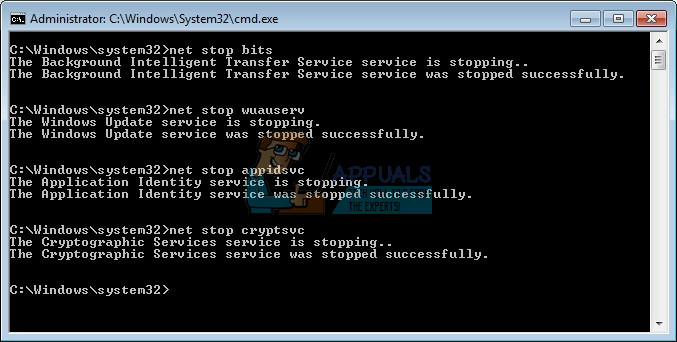
- After this, you will have to delete some files which should be deleted if you want to continue with resetting the update components. This is also done via Command Prompt with administrative privileges.
Del “%ALLUSERSPROFILE%\Application Data\Microsoft\Network\Downloader\qmgr*.dat”
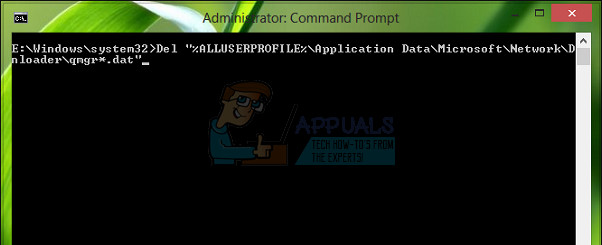
- The following step can be skipped if this is not last resort. This step is considered to be the aggressive approach but it will definitely reset your updating process from its very core. So we can recommend that you try this out. It has been suggested by a lot of people on online forums.
- Change the name of the SoftwareDistribution and catroot2 folders. In order to do this, at an administrative command prompt, copy and paste the following commands and click Enter after copying each one.
Ren %systemroot%\SoftwareDistribution SoftwareDistribution.bak
Ren %systemroot%\system32\catroot2 catroot2.bak
- The following commands will help us reset the BITS (Background Intelligence Transfer Service) and the wuauserv (Windows Update Service) to their default security descriptors. Make sure you don’t modify the commands below so it’s for the best if you simply copy them.
exe sdset bits D:(A;;CCLCSWRPWPDTLOCRRC;;;SY)(A;;CCDCLCSWRPWPDTLOCRSDRCWDWO;;;BA)(A;;CCLCSWLOCRRC;;;AU)(A;;CCLCSWRPWPDTLOCRRC;;;PU)
exe sdset wuauserv D:(A;;CCLCSWRPWPDTLOCRRC;;;SY)(A;;CCDCLCSWRPWPDTLOCRSDRCWDWO;;;BA)(A;;CCLCSWLOCRRC;;;AU)(A;;CCLCSWRPWPDTLOCRRC;;;PU)

- Let’s navigate back to the System32 folder in order to proceed with the solution at hand.
cd /d %windir%\system32
- Since we have completely reset the BITS service, we will need to reregister all of the files necessary for the service to run and operate smoothly. However, each of the files requires a new command in order to make it reregister itself so the process may end up being lengthier than what you are used to. Copy the commands one by one and make sure you don’t leave out any of them. You can find the complete list if you follow this link.
- Some files may have been left behind after these processes so we are going to look for them in this step. Open the Registry Editor by typing “regedit” in either the search bar or the Run dialog box. Navigate to the following key in Registry Editor:
HKEY_LOCAL_MACHINE\COMPONENTS
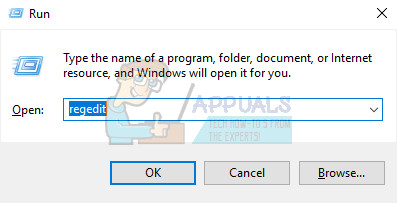
- Click on the Components key and check the right side of the window for the following keys. Delete them all if you locate any of them.
PendingXmlIdentifier
NextQueueEntryIndex
AdvancedInstallersNeedResolving
- The next thing we are going to do is reset Winsock by copying and pasting the following command back into the administrative Command Prompt:
netsh winsock reset
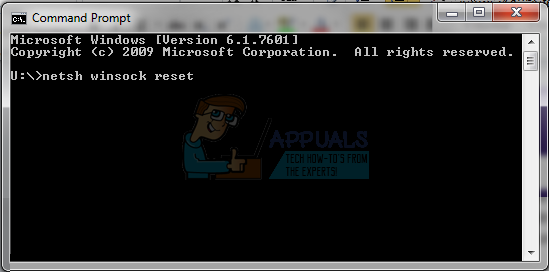
- If you are running Windows 7, 8, 8.1, or 10, at a command prompt, copy the following command, and tap the Enter key:
netsh winhttp reset proxy
- If all of the steps above have gone through painlessly, you can now restart the services you killed in the very first step by using the commands below.
net start bits
net start wuauserv
net start appidsvc
net start cryptsvc
- Restart your computer after following through with all of the steps which are listed.
Solution 3: Try Using a New Account
Follow the instructions below in order to create a new user account on Windows 10 and try running the update when logged in with the new account. Refer to the steps below to create a new User Account:
Creating a Microsoft Account:
- Open Settings either by clicking on the gear icon which is located just above the power button in the Start menu or by searching for it in the search bar.

- Open the Accounts section in Settings and select the Family and other people option.
- Choose the Add someone else to this PC option located there.
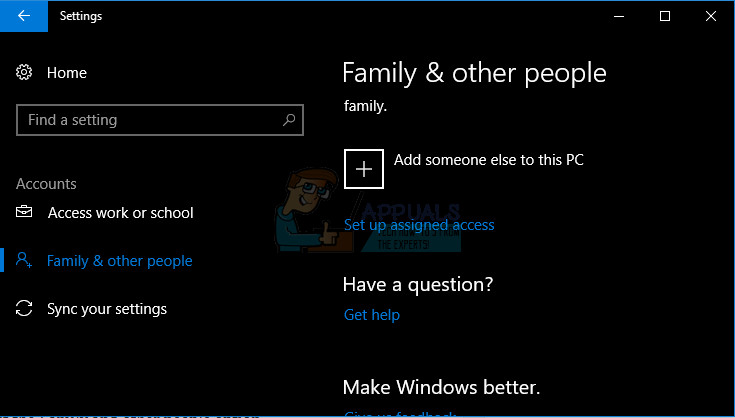
- You will need to provide info about the account you are about to add in this process by doing it according to the instructions below:
- If the account you’re adding already exists under a Microsoft email, enter it now.
- If the account you’re adding is not a Microsoft account, enter the email you wish to use for it. Make sure you choose a valid email
- If you want to create a new email address straight from the Add an account menu, click Sign up for a new email address.
- Add a child’s account is useful if the user you are creating the account for is a child.
- Follow the instructions to finish setting up the account.
Creating a Local Account
- Open Settings either by clicking on the gear icon which is located just above the power button in the Start menu or by searching for it in the search bar.

- Open the Accounts section in Settings and select the Other accounts option.
- Choose the Add an account option located there, and then click on the Sign in without a Microsoft account option which is usually not recommended.

- Create a Local account and proceed.
- Enter a username for this new account.
- If you want this account to be password-protected, you can add a character password, a password hint, and proceed by clicking Next.

- Click the Finish button in order to finish creating a new account.
Solution 4: Running Several Checks and Scans
A good thing you could do is run the System File Checker (SFC). This is quite a useful tool preinstalled to each Windows computer which will scan your storage for missing or corrupt system files. The tool will also replace or fix the system files automatically which can prove to be useful in a variety of different cases.
Additionally, run the DISM tool beforehand and you can also try this particular PowerShell Command in which has proven to help users deal with this update error code.
- It’s advisable to run the DISM (Deployment Imaging and Servicing Management) tool before running SFC. This tool will scan your Windows image for errors and it will fix them automatically. Take a look at our guide on how to use this tool effectively https://appuals.com/use-dism-repair-windows-10/
- In order to access a detailed guide on how to use the System File Checker tool safely and effectively, please refer to our handy guide by clicking https://appuals.com/how-to-run-sfc-scan-in-windows-10/
- Open PowerShell by right-clicking on the Start menu and selecting the Windows PowerShell (Admin) option in order to open the tool with administrator privileges.

- Copy and paste the following command and make sure you click Enter afterwards.
Get-AppXPackage -AllUsers |Where-Object {$_.InstallLocation -like “*SystemApps*”} | Foreach {Add-AppxPackage -DisableDevelopmentMode -Register “$($_.InstallLocation)\AppXManifest.xml”}
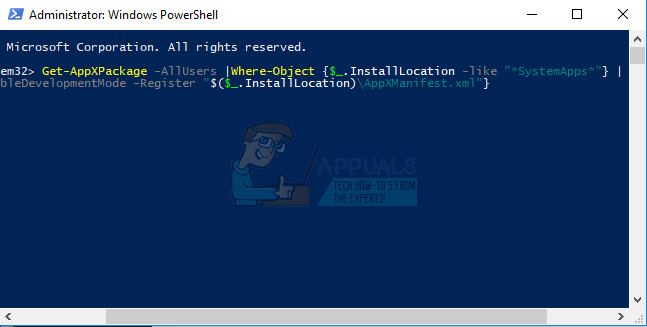
- Restart your computer and check to see if your issue has been resolved.
Solution 5: Setup Your Time and Date Settings Correctly
If you Date and Time settings have been misconfigured, you may not be able to install any updates at all. Additionally, other features on your computer may begin experiencing problems and they may seize to open at all. Follow the instructions below in order to setup date and time correctly.
- Open Date and Time settings by opening the Start menu, opening the Settings app by clicking on the gear icon above the power icon, choosing the Time & language option, and navigating to the Date & time tab.

- In the Date and Time tab, make sure that your computer’s date and time are correct. If the time is not correct, you can try turning the Set time automatically option on or off, depending on the default state.
- To change the date, under Date, click the dropdown menu in order to find the current month in the calendar, and then click the current date.

- To change the time, under Time, click the hour, minutes, or seconds that you want to change, and then slide the values until you settle for the one correct according to your location.
- When you have finished changing the time settings, click OK.
Solution 6: Install the Update Manually
It appears that most users reported receiving this issue for a single update which simply might mean there are some issues with the update or the Microsoft server you are receiving the update from. Additionally, there may be some issue with the way the update is delivered to your computer.
Luckily, you can install the update manually by visiting the site below where you can download and install updates manually.
- Visit the official Microsoft site in order to find out which is the latest released update for your operating system. It should be located at the top of the list at the left part of the site with the current Windows 10 version at the top.

- Copy the KB (Knowledge Base) number together with “KB” letters as well (e.g. KB4040724).
- Open the Microsoft Update Catalog and perform a search by clicking on the search button at the top right corner.

- Click on the Download button to the left and choose the architecture of your PC (32bit or 64bit). Make sure you know the architecture of your PC’s processor before choosing this option.
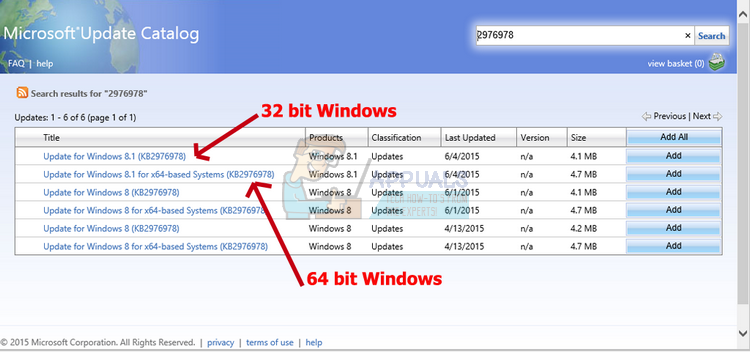
- Run the file you downloaded and follow the instructions on screen carefully in order to complete the updating process.
- After the update has finished, make sure you restart your computer and wait to see if the same issue occurs with the next update released by Microsoft.